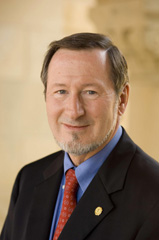Previous speakers and artists
| |
 |
|
December 12-14, 2012
How science changes our lives
Prof. Douglas D. Osheroff
|
|
|
Keynote Speaker
Professor Douglas D. Osheroff is a 1996 Nobel Laureate for Physics at the Department of Physics of Stanford University who was awarded the Nobel Prize for his discovery of superfluidity in the isotope helium-3. Superfluidity in 3He is a neutral analog to superconductivity in metals, but here the 3He atoms play the role that electrons play in conventional superconductors. In addition, there is no lattice in liquid 3He, so the interactions that lead to the formation of ‚Cooper Pairs' results from ferromagnetic spin fluctuations, and not virtual phonons in the lattice as is the case in most superconductors. Superfluid 3He was the first example of a BCS state in which the Cooper pairs possess a net angular momentum. Professor Osheroff's work was considered a breakthrough in low-temperature physics, and in the course of his research on helium-3 he developed an early form of magnetic resonance imaging, but only in one spatial dimension.
Douglas D. Osheroff attended the California Institute of Technology (Caltech), where he took the famous two year course in physics developed by Nobel Laureate Richard Feynman. In his senior year Douglas Osheroff became fascinated with the physics of low temperatures and as a result decided to go into condensed matter physics.
After graduating from Caltech, Douglas Osheroff entered Cornell University for graduate study in 1967. Working in the university's Laboratory of Atomic and Solid State Physics with David Lee and Robert C. Richardson, he and his colleagues began to investigate the behavior of liquid helium-3 at temperatures within a few thousands of a degree of absolute zero.
It was during this time that Professor Osheroff noticed a jump in the heat capacity of the liquid 3He, which marks the conditions under which helium-3 changes from an ordinary liquid to a superfluid. This discovery sparked intensive research into superfluid helium-3 and other so-called "quantum liquids", as it enabled scientists to study the types of quantum mechanical effects in large, visible systems that could previously only be studied at the atomic and subatomic level. It is from this discovery that Lee, Richardson and Osheroff would later be jointly awarded the Nobel Prize for Physics in 1996.
In 1972 Professor Osheroff moved to AT&T Bell Laboratories in New Jersey, where he continued his work into helium-3 superfluidity. Between 1973 and 1978 he measured many characteristics of the superfluid phases. He continued his research at Bell Laboratories as head of the Department of Low Temperature Research until 1987, when he came to Stanford University, along with his friend Steven Chu, who would later be appointed Secretary of Energy by President Obama. At Stanford, Professor Osheroff has been the J.G. Jackson and C.J. Wood Professor of Physics and the Gerhard Casper University Fellow for Undergraduate Education. His research there still focuses on the properties of condensed matter near the absolute zero of temperature. He has also served as Chair of the Physics Department at Stanford from 1993-96 and again from 2001-04.
Professor Osheroff has received numerous honors for his research. Besides the Nobel Prize, these include the Sir Francis Simon Memorial Award, the Oliver E. Buckley Condensed Matter Physics Prize and the MacArthur Prize Fellowship Award. In 1991 he received the Walter J. Gores Award for Excellence in Teaching from Stanford University. Professor Osheroff is a member of the American Academy of Arts and Sciences and the National Academy of Sciences.
Besides his work in Physics, Professor Osheroff was appointed to the Columbia Accident Investigation Board in 2003 following the Space Shuttle Columbia disaster, and he currently serves on the board of advisors of Scientists and Engineers for America, an organization focused on promoting sound science in American government.
As a fascinating application of superfluidity in helium-3, the phase transitions to superfluidity in helium-3 have over the years been used by experimental research teams to test a theory regarding how cosmic strings can be formed in the universe. These immense hypothetical objects, which are thought possibly to have been important for the forming of galaxies, could have arisen as a consequence of the rapid phase transitions believed to have taken place a fraction of a second after the Big Bang. The research team used rapid local heating in the 3He superfluid using both X-rays and neutron capture in their superfluid 3He to simulate these events that occurred in the early universe. When these were rapidly cooled back through the superfluid transition, balls of vortices were formed. It is these vortices that are presumed to correspond to the cosmic strings.
SCHEDULE
Wednesday, December 12, 2012
10:00 Dialogue with high school students of Samsen Wittayalai and Mahidol Wittayanusom Schools, amongst others, at Mahidol University Bangkok (Thailand) (not a public event)
14:00 Keynote speech and dialogue at Mahidol University in Bangkok (Thailand)
Information and free seat reservation:
phone/fax (02) 201-5070, online registration: www.sc.mahidol.ac.th
Friday, December 14, 2012
14:00Keynote speech and dialogue at Vietnam National University in Hanoi (Vietnam)
Information and free seat reservation:
phone (091) 322-2632, email anhlt.vnu@gmail.com |
|